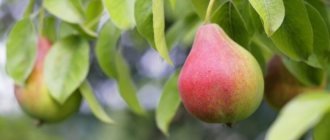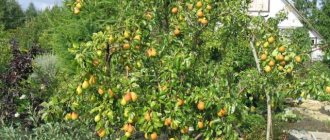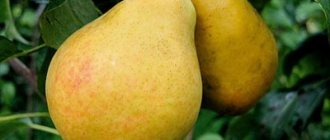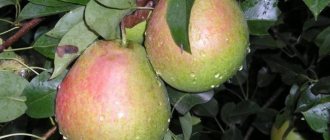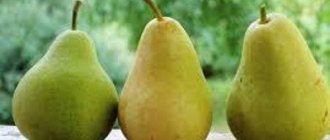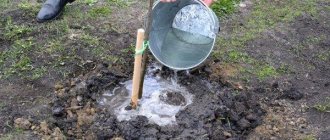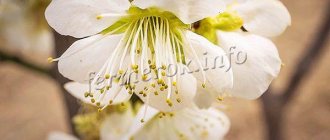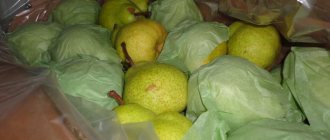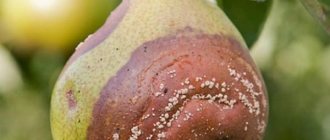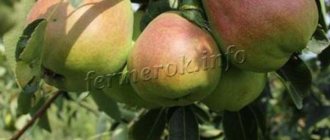Pear is a fruit crop that can be grown both in the south and in regions with an unstable climate. When choosing a seedling, it is necessary to take into account frost resistance, taste and disease resistance. The best representative for cultivation in the Central region is the Rogneda variety. The pear is unpretentious, ripening in autumn. Valued for its juicy, aromatic, round-shaped fruits. Descriptions, photos and reviews of the Rogneda pear give a complete picture of the frost-resistant variety.
Description of Rogneda pear
The Rogneda variety was grown by Russian scientists by crossing Forest Beauty and Tema pears. Over many years of research, the Rogneda pear was included in the State Register and recommended for cultivation in regions with an unstable climate.
Rogneda pear is a medium-sized variety. The height of an adult tree is no more than 5 m. The wide-pyramidal crown is compact, formed by slightly curved, brown-olive shoots. The compactness of the crown is explained by the slow growth of branches and the small formation of young shoots.
The tree is densely leafy. The oblong, dark emerald leaves are medium in size and have jagged edges.
History of the variety's creation
Rogneda pear (Pink family) is an early autumn variety, the result of crossing varieties such as Tyoma and Lesnaya Krasavitsa.
The variety was tested at the Moscow Agricultural Academy. K. A. Timiryazev since 1987, and since 2001 included in the State Register. Initially, it was bred for the purpose of cultivation in the Central, Northwestern and Volga-Vyatka regions. With the development of gardening, it became further widespread.
Did you know? Today there are more than a thousand varieties of pear
.
Fruit characteristics
Rogneda pear is an early ripening variety with an autumn ripening period. The first fruits appear 4 years after planting, at the end of August.
The rounded fruits are located on a thick stalk. They have a waxy surface and a light yellow color with a delicate pink blush. The variety is capable of crumbling after over-ripening, so harvesting should not be delayed. It is recommended to pick pear fruits 2 weeks before full ripeness and place them in a dark place until ripening.
The fruits weighing 120 g are covered with a thin but dense peel and have juicy, aromatic cream-colored pulp. The fruits contain:
- acids – 0.15%;
- sugar – 7.5%;
- dry matter – 13.7%.
A special feature of the Rogneda pear is its nutmeg aroma, very reminiscent of the smell of southern varieties. Due to their sweet taste and delicate aroma, pears are consumed fresh, used for preparing fruit salads, as well as for various preservations: compotes, jams and preserves. Due to its high sugar content, the variety is used in winemaking.
Recommendations for harvesting and storing crops
Rogneda pear is excellent for fresh consumption or canning
Rogneda is a fast-growing variety. The first harvest is harvested after 3–4 years. The average productivity of one pear is 50 kg. But under favorable conditions, the yield can reach 100 kg of crop. Harvest ripeness of the fruits occurs in mid-August, and consumer ripeness in the third ten days of August or early September.
Harvesting is recommended in dry weather in the evening. At room temperature, fruits are stored for 10 to 20 days. And in a cellar or refrigerator at 2–4°C and a humidity of 85–90% they will last for two months.
Pears of this variety are suitable for making jam, compotes, pie filling, and also for fresh consumption.
Important! Rogneda pears quickly fall off, which significantly reduces their shelf life, so it is advisable to pick the fruits in a slightly unripe state.
Pros and cons of Rogneda pear
The Rogneda pear gained popularity among gardeners for its positive qualities. These include:
- precocity;
- immunity to diseases;
- resistance to cold and short-term drought;
- unpretentiousness in cultivation and care;
- high productivity;
- versatility in application;
- good appearance and light nutmeg aroma;
- The shelf life of fresh fruits is 3 months.
Important! The Rogneda pear has one drawback - the tendency of ripe fruits to shed.
Hereditary traits
What hereditary characteristics of “Rogneda” did G.P. Rylov regard as advantages?
First of all:
- frost resistance and invulnerability to frost;
- complex resistance to the main types of Rosaceae diseases;
- early dates of fruiting (in the 3rd year);
- original taste with notes of nutmeg;
- high yield (50 kg per tree);
- marketability and good shelf life of fruits (up to 2 months at low temperatures);
- low demands on the agricultural background;
- breeding prospects.
The following can also boast of unpretentiousness: Bere Russkaya, Quiet Don, Skazochnaya, Svarog and Larinskaya.
From its European parent, “Rogneda” inherited fruit shedding when ripe . And in the process of variety testing, another inherited quality was revealed: irregular fruiting.
A ripe pear is torn from the tree due to the softening of the junction with the cutting. Therefore, picking pears, if you allow them to ripen completely, is a simple matter. This is where the popular expression about the occupation of idlers comes from: “poaching pears.”
Planting and caring for Rogneda pear
It is better to purchase seedlings from trusted suppliers or nurseries. A young tree should have a well-developed root system and a healthy trunk with a diameter of at least 1.5 cm, without mechanical damage. Plants with a closed root system can be planted in spring, summer or autumn. Pear seedlings with bare roots take longer to adapt to a new location, so they can be planted in the spring, before the leaves bloom, and in the fall, a month before the onset of cold weather.
A seedling of the Rogneda pear variety is purchased at 2 years of age; before purchasing, you must read the description of the variety and view the photo.
Landing rules
For rapid growth and development, proper planting is necessary. To do this, prepare a hole 2 months before planting the pears. A hole is dug 80 cm wide and 60 cm deep. The dug soil is mixed with humus and mineral fertilizers. If the soil is clayey, add sand. The prepared soil is poured into a mound into the planting hole and spilled.
Advice! This procedure is necessary to settle the soil and dissolve minerals.
For better survival, the pear seedling is kept in warm water for several hours with the addition of a growth stimulant. Before planting, the root system is carefully straightened and laid out on a prepared mound. The seedling is sprinkled with earth, compacting each layer so that there is no air cushion. For a properly planted seedling, the root collar should rise 5 cm above the ground surface. The top layer is compacted, watered and mulched.
A young pear seedling will sit firmly in the ground only 2 years after planting, after the root system has developed and strengthened, so the plant needs support. To do this, place a peg nearby, to which a pear is tied.
Watering and fertilizing
The yield and taste of the fruit depend on proper watering. Rogneda pear is a drought-resistant variety, but with a lack of moisture, the plant develops and bears fruit poorly. Therefore, watering is an important element in care. Since the root system of an adult plant is well developed and goes deep into the ground, it can find moisture on its own. But there are watering standards.
For a young pear:
- during the growing season - up to 3 buckets of warm water are used per specimen;
- in summer – 50 liters of water;
- in the fall before preparing for winter - 150 liters of water.
For a fruiting tree:
- from flowering to harvest - 5 buckets of water;
- during leaf fall - 150 liters of water.
Watering of pears is carried out in specially dug grooves along the perimeter of the trunk, to a depth of 15 cm. After irrigation, the trench is covered with earth, the trunk circle is loosened and mulched.
Timely fertilizing also affects productivity. It will protect against diseases, promote rapid development and the formation of a large number of fruits. An excess of fertilizers, as well as a lack of them, can have a detrimental effect on a pear tree. If the seedling is planted in fertile soil, then it will not need feeding for 3 years.
Fertilizer application scheme for one pear tree:
- In early spring, before the buds open, 10 buckets of organic matter or 0.5 kg of urea are added to the tree trunk circle. Urea is applied strictly according to the instructions; fresh manure is not used as a top dressing.
- During the flowering period - complex mineral fertilizers: add 50 g of superphosphate, 40 g of potassium sulfate and 1 liter of diluted manure to a bucket of water. Each plant uses 4 buckets.
- When forming a crop, 0.5 kg of nitrophoska and 1 g of sodium humate are diluted in 10 liters of water. Up to 5 buckets are poured under each tree.
- After harvesting, 300 g of superphosphate and potassium sulfate are scattered around the pear.
Trimming
The quality and quantity of the harvest depends on a properly formed crown. Pruning of the Rogneda pear variety is carried out in early spring, before sap flow, to thin out and correct the crown. In autumn - sanitary pruning, removal of dry, damaged branches. The work is carried out with a sharp, sterilized instrument. Formation of a pear tree:
- The annual pear is shortened, leaving 50-60 cm above the ground. Thanks to this pruning, branches from the lower buds will begin to develop.
- In 2-3 year old plants, the central conductor is shortened by ¼ of the length. Excess shoots are also removed, leaving 4 powerful branches growing at an acute angle.
- Branches growing at an acute angle and inside the crown are cut strictly to fit the ring.
- If flower buds have formed on a vertical branch, it is redirected horizontally and fixed to the ground with twine.
- When removing shoots more than 3 cm thick, to prevent damage to the bark, the branch is cut first from below, then from above.
- All cuts are covered with garden varnish.
Whitewash
Whitewashing of pears is carried out in early spring, before the earth warms up, and in late autumn. It protects the tree trunk from sunlight. Lime is used as a solution, which is diluted in warm water to the consistency of thick sour cream.
Method of carrying out the work:
- Whitewashing is carried out in dry sunny weather.
- Before processing, the trunk is cleaned with a metal brush or wooden scraper to remove moss, lichen and damaged bark.
- The cracks are covered with garden varnish.
- For whitewashing, use a paint brush or paint sprayer.
- The trunk, skeletal branches of the lower tier, and the fork are whitewashed.
- Young trees with smooth bark do not need whitewashing, as it can clog the pores and harm the plant.
Preparing for winter
Prepare the pear for frost immediately after leaf fall. To do this, you need to listen to the advice of experienced gardeners:
- The area around the trunk is cleared of fallen leaves and other plant debris.
- The tree is watered generously, the soil is loosened and covered with a 20 cm layer of sawdust.
- If there are damaged areas on the trunk, they are cut off to healthy tissue, the cut site is treated with a copper-containing preparation and covered with garden pitch. Moss and lichen are removed with a metal brush or wooden scraper.
- Rogneda pear is a frost-resistant variety. An adult tree does not need shelter. The trunk of a young tree is wrapped in burlap or spruce branches.
Landing rules
Like other pear trees, the Rogneda variety does not tolerate transplantation. That is why you need to calculate everything in advance. This applies not only to the choice of site, seedlings, timing and characteristics of planting. It is necessary to study the agricultural technology of growing trees.
Recommended timing
Rogneda pear can be planted in spring or autumn, depending on the climate of the region. If the work is scheduled for autumn, you need to wait until the leaves fall. At this time, the movement of juices slows down.
Spring planting is planned for early April, before sap flow begins. The seedlings have time to get stronger before the hot weather begins. In addition, young pears planted in the spring grow their crown over the summer and go into winter full of strength.
Attention! In the regions of the Urals and Siberia, it is better to plant Rogneda pears in the spring.
Site selection and soil preparation
The variety is unpretentious to soils, but grows better on gray loamy soils and chernozem with neutral acidity. If this indicator is exceeded, the situation can be corrected by adding dolomite flour or slaked lime. Before digging, it is enough to add about 0.5 kg per 1 square meter. m.
Pears need to be planted in a sunny area, but not in the sun itself. The southern or southeastern corners of the garden are best suited. The area must be ventilated, but fruit trees cannot tolerate drafts.
Warning! Groundwater must be at a depth of at least 2 m, since the root system does not tolerate large amounts of moisture.
The pits are prepared in advance: if planting is planned for spring, then in the fall. During autumn work, the site is prepared in 3-4 weeks. After all, the soil must settle well so that the roots do not go far down. The depth of the pit is at least 80 cm, diameter is from 100 to 120 cm.
For the top layer, the soil is prepared specially. It consists of:
- two buckets of humus;
- 150 g of potassium sulfate or 0.8 kg of wood ash.
Advice! If the soil is sandy, you need to add three buckets of peat. Sand is added to clay soil.
Selection and preparation of seedlings
To purchase seedlings, it is best to contact nurseries or large gardening farms. They must be no older than two years. One-year-old seedlings have 1-2 side branches, their length is about 12 cm. On two-year-old seedlings, some branches grow up to 30 cm. The roots are the same length.
When choosing, you need to carefully examine the entire seedling. There should be no damage or signs of rotting on the root system. The trunk is without growths and wounds. It is worth purchasing plants in containers, as they take root better. Seedlings with an open root system must be wrapped in damp burlap for transportation.
Before planting, plants with an open root system are pruned and then soaked in a solution of mullein and clay. The honey composition also works well. Container seedlings are watered abundantly so as not to damage the roots when planting.
Landing algorithm
In order for the Rogneda pear to take root well and develop successfully, it must be planted correctly:
- A small elevation is made in the center of the hole, and a seedling is planted on it. A peg is driven in at a distance of 30 cm from the seedling to secure the plant.
- The roots are carefully straightened to avoid creases, sprinkled with nutritious soil and compacted.
- A circle around the trunk is formed, the diameter of which must be at least 40 cm, and the depth is 10 cm. Two buckets of water are poured into it.
- A Rogned pear seedling is tied to a peg. Some of the leaves are removed so that the plant devotes all its energy to rooting.
- Mulch the tree trunk to retain moisture.
Important! When planting, you need to ensure that the root collar is 7 cm above the soil level.
Productivity
Rogneda pear is a high-yielding variety; with proper care, up to 5 buckets of fruit can be collected from one mature tree. The high yield is explained by the fact that the pear tolerates sudden changes in temperature well and continues to grow and develop even with the sudden return of spring frosts. Due to its unpretentiousness and high yield, the Rogneda pear is grown in summer cottages and on an industrial scale.
Important! If you follow the rules of care, the plant continuously bears fruit for 25 years.
Pedigree of the new hybrid
The pear variety "Rogneda", a description and photo of which will be below, was created by crossing existing varieties in several stages through pollination. The first, at the beginning of the 20th century, to appear in the Khabarovsk nursery was an early autumn pear variety - “Tyoma”.
It consolidated the climatic endurance
of the Ussuri pear and the Baltic hybrid of folk selection - “Finnish Yellow” . Along with it, 3 more daughter forms with similar characteristics were recorded: “Fields”, “Olga” and “Lida”.
All new hybrids had the original ( apple-like) roundness of the fruits , after which the entire assortment of pears was traditionally divided into two groups (based on the shape of the fruit):
- round (“Lukashovki” - named after the breeder);
- duli (Old Russian name for pears, borrowed from colloquial Polish).
So, one of the parents of “Rogneda” was the proven “ Lukashovets ” - “Tema”.
He conveyed to the new hybrid:
- fruit shape;
- ability to grow and bear fruit in the northern regions of the European part of the country, Siberia and the Far East. In the Amur region it grows in the form of stanza, which is very convenient during long, snowy winters;
- extended shelf life;
- high marketability of fruits;
- the ability to manifest self-fertility during the flowering period (as an option).
The second parent of “Rogneda” was I.V. Michurin’s favorite breeding material - the Belgian variety “ Forest Beauty ”, which has more than 30 daughter forms and an excellent rating as a derivative species.
A proven European variety has awarded a new hybrid:
- high productivity over 15-20 years of reproductive age;
- outstanding consumer qualities;
- undemanding to soil composition and agrotechnical measures;
- drought resistance;
- winter hardiness;
- durability.
Reference: Among the most common Rosaceae species in domestic gardens, the pear is the crop that requires the least regular care.
Diseases and pests
Rogneda pear is immune to scab and fruit rot. However, with improper and untimely care, the following diseases can affect the pear:
- Powdery mildew - the trunk, branches, leaves and ovaries are covered with a white coating, which over time acquires a rusty color. You can save the tree by treating it with a 10% solution of potassium chloride. After 2 weeks, treatment is carried out with a 0.5% solution prepared from potassium salt and urea.
- Sooty fungus - fruits and leaves become covered with a black coating. Wood is treated with insecticides.
- Rust - orange-colored growths form on the leaf blade. Without treatment, the disease spreads to the fruits. The fight consists of treating the plant with a copper-containing preparation before flowering. After fruiting, treatment is carried out with 1% Bordeaux mixture.
In order to avoid problems and get a regular harvest, it is necessary to regularly loosen the tree trunk circle, collect and burn fallen leaves, and apply fertilizing in a timely manner.
Appearance of the tree and description of the fruit
The tree can reach a height of 4 m. It has a round, sometimes ellipsoidal crown. The branches grow oval-shaped, dark green leaves with jagged ends. The buds are cone-shaped and short.
The fruit tree bears fruit at 3-4 years of age. The fruits are small in size, weighing 120–140 g. The fruit is pear-shaped and has a glossy yellow skin. Inside it consists of white pulp with a sweet and sour taste. Its juicy consistency with a pronounced pleasant aroma is distinguished by spicy notes of nutmeg.
Rogneda bears fruit annually and has positive yield dynamics. The average lifespan of a tree is 70 years.
Reviews of the Rogneda pear variety
Stepanyuk Olga Pavlovna, 56 years old, Lviv
I've been growing pears for a long time. There are many varieties: there are early and late. Among the autumn varieties, I highlight the Rogneda pear. It is medium-sized, unpretentious and high-yielding. From an adult tree, the harvest is enough for fresh consumption, for storing for the winter, and even for sale. Although appearance is not an advantage of the variety, the product quickly leaves the counter for its nutmeg aroma and sweet pulp. I advise everyone to plant an early ripening pear, which begins to bear fruit 3 years after planting.
Puchkov Ivan Pavlovich, 60 years old, Vologda
I read reviews about the Rogneda pear and planted a seedling to the delight of my grandchildren. The tree began to bear fruit 4 years after planting. In the first year the harvest was meager, but in the second year I removed 4-5 kg of fruit from the tree. The pear is very tasty, sweet with a nutmeg aroma. The peel is thin, dense, golden yellow with a slight red blush. The variety does not require special care; it overwinters without shelter.
Reviews from gardeners
This late-ripening pear variety is excellent for growing in the middle zone. And the highlight of this pear variety is its taste, reminiscent of the taste of southern pears. Ripe pears are golden yellow with an orange-red tint. These pears can be stored in the refrigerator for up to 2.5 months.
Vasily Petrovich https://forumsadovodov.com.ua/viewtopic.php?f=7&t=1470
This year we had 2 first fruits on Rogneda, so red and growing in pairs, like cherries. And at the end of summer they fell off without ripeness. But still interesting.
GRUNYA https://dacha.wcb.ru/lofiversion/index.php?t14388-250.html
In four years, my Rogneda from a grafted cutting (on an Ussuri pear) has grown to almost three meters in height and is not going to stop yet. The first harvest was in the fourth year of life - this is normal, two dozen pears ripened, not very large, but sweet and pleasant to the taste.
Sasha https://forum.tvoysad.ru/plodovye-derevya-f30/grusha-pyrus-t181-120.html
Rogneda is a variety resistant to cold and scab, characterized by early fruiting, productivity, excellent taste and presentation of the fruit. Today Rogneda is one of the favorite varieties of many gardeners.
- Author: Anna Gradskaya
The desire to learn something new every day helps improve professional skills. Rate this article:
- 5
- 4
- 3
- 2
- 1
(3 votes, average: 2.7 out of 5)
Share with your friends!
Fertilizer application
Fertilizer is a very important step in growing. The frequency and amount of fertilizer applied is determined taking into account the growth of the tree.
When planting, it is worth adding organic fertilizers to the soil:
- Wood ash (700-800 g)
- Humus (4-5 kg)
During the digging period, you can add the following mineral fertilizers:
- phosphate rock (30-40 g)
- ammonium nitrate (15-25 g)
- superphosphate (50-60 g)
If necessary, the tree should be sprayed with urea at a rate of 50-100 grams per 10 liters of water.
Further care
With proper care, the Rogneda pear produces a stable harvest every year.
Watering mode
In the middle zone, watering of adult Rogneda pears is carried out as needed, based on weather conditions. In dry summers, limit yourself to 4-5 waterings per season.
Young trees are watered once a week.
Seasonal fertilizer scheme for Rogneda pear
In the fall after fruiting and in the spring before flowering, mineral or organic fertilizers are applied to the soil. Pear is demanding in terms of nitrogen and potassium content. Mineral fertilizers used include superphosphate, urea, ammonium nitrate, and potassium sulfate. Norms are calculated for each area based on the chemical composition of the soil.
Instead of mineral fertilizers, you can get by with organic fertilizers - humus, manure, bird droppings.
Whitewash
Whiten with bleach in the spring to prevent sunburn and insect pests.
In autumn, trees are whitened to prevent diseases. The trunk is covered with whitewash up to the first branches.
Crown formation
An oval or pyramid-shaped crown is formed in young trees up to 5 years old. It is not recommended to prune adult Rogneda pears. This leads to a decrease in yield.
Seasonal treatments
Carried out for preventive purposes:
- During the leaf-blooming period, Rogneda pears are treated with solutions of potassium chloride and urea to prevent damage by powdery mildew.
- Before flowering and after fruiting, trees are sprayed with solutions of copper oxychloride and Bordeaux mixture to prevent the formation of rust on the leaves.
- To destroy insect pests before flowering and after harvesting, the branches and trunk are treated with karbofos or chlorophos.
Winter protection
In the fall, the soil around the pear is dug up and watered, and dry and diseased branches are sanitized.
Before wintering, the trunk is covered with insulating material to protect it from rodents.
Transfer
Rogneda pear can be replanted in extreme cases.
A prerequisite is that the tree is dug up with its roots completely covered with soil. Transplanting with exposed roots leads to its death.
Features of cultivation
Landing rules
The variety is not at all picky about the soil composition; the pear will grow well in both sandy and heavy loamy soils. But when choosing a location, despite the cold resistance of the trees, it is best to give them a sunny place, hidden from the winds.
The tree's modest-sized crown and not very spreading horse system allows them to be planted at a distance of four meters, instead of the usual six. It is enough to step back three meters from houses, outbuildings and fences.
How to get rid of bud mite on currants in spring: pest control measures
An important point in planting is preparing the pit. This work is carried out 3-4 months before transplanting the seedlings. The depth of the hole should be at least 60 cm and the width more than 80 cm. Such a hole should be filled two-thirds with fertile soil mixed with fertilizers and left for a long time. This is done so that the soil naturally settles and the minerals dissolve and take on a form that is easily accessible to the pear.
It should be taken into account that only after two years the young seedling will be firmly fixed in the planted place with the help of its own overgrown roots, and until that time it needs good support. Therefore, a wooden or metal stake is driven into the planting pit, stepping back a little from the center, to which the pear is tied after planting.
The remaining stages of planting work are identical to the simple algorithm for replanting any fruit tree.
